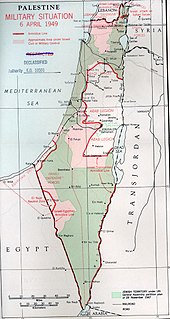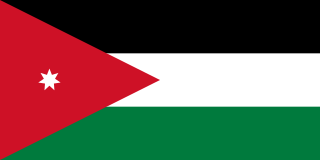
United Nations Security Council Resolution 242 (S/RES/242) was adopted unanimously by the UN Security Council on November 22, 1967, in the aftermath of the Six-Day War. It was adopted under Chapter VI of the UN Charter. The resolution was sponsored by British ambassador Lord Caradon and was one of five drafts under consideration.

The United Nations Truce Supervision Organization (UNTSO) is an organization founded on 29 May 1948 for peacekeeping in the Middle East. Its primary task was providing the military command structure to the peace keeping forces in the Middle East to enable the peace keepers to observe and maintain the cease-fire, and as may be necessary in assisting the parties to the Armistice Agreements in the supervision of the application and observance of the terms of those Agreements. The command structure of the UNTSO was maintained to cover the later peace keeper organisations of the United Nations Disengagement Observer Force (UNDOF) and the United Nations Interim Force in Lebanon (UNIFIL).

The 1949 Armistice Agreements are a set of armistice agreements signed during 1949 between Israel and neighboring Egypt, Lebanon, Jordan, and Syria to formally end the official hostilities of the 1948 Arab–Israeli War, and establish armistice lines between Israeli forces and Jordanian-Iraqi forces, also known as the Green Line.

United Nations General Assembly Resolution 194 was adopted on December 11, 1948, near the end of the 1948 Arab–Israeli War. The Resolution defined principles for reaching a final settlement and returning Palestine refugees to their homes. It resolved that “refugees wishing to return to their homes and live at peace with their neighbours should be permitted to do so at the earliest practicable date, and that compensation should be paid for the property of those choosing not to return and for loss of or damage to property which, under principles of international law or equity, should be made good by the Governments or authorities responsible.”
The Green Line, or (pre-) 1967 border or 1949 Armistice border, is the demarcation line set out in the 1949 Armistice Agreements between the armies of Israel and those of its neighbors after the 1948 Arab–Israeli War. It served as the de facto borders of the State of Israel from 1949 until the Six-Day War in 1967.
The Lausanne Conference of 1949 was convened by the United Nations Conciliation Commission for Palestine (UNCCP) from 27 April to 12 September 1949 in Lausanne, Switzerland. Representatives of Israel, the Arab states Egypt, Jordan, Lebanon and Syria, and the Arab Higher Committee and a number of refugee delegations were in attendance to resolve disputes arising from the 1948 Arab–Israeli War, mainly about refugees and territories in connection with Resolution 194 and Resolution 181.

The three-line United Nations Security Council Resolution 338, adopted on October 22, 1973, called for a ceasefire in the Yom Kippur War in accordance with a joint proposal by the United States and the Soviet Union. The resolution stipulated a cease fire to take effect within 12 hours of the adoption of the resolution. The "appropriate auspices" was interpreted to mean American or Soviet rather than UN auspices. This third clause helped to establish the framework for the Geneva Conference (1973) held in December 1973.
United Nations Security Council Resolution 89, adopted on November 17, 1950, after receiving complaints from Egypt, Israel, Jordan and the Chief of Staff of the Truce Supervision Organization regarding the implementation of the Armistice Agreements designed to end the Arab-Israeli War the Council requested the Egypt-Israel Mixed Armistice Commission give urgent attention to a complaint of expulsion of thousands of Palestinian Arabs. The Council called upon both parties to give effect to any finding by the Commission, repatriating any such Arabs who the Commission believes to be entitled to return. The Council then authorized the Chief of Staff of the Truce Supervision Organization to recommend to Israel, Egypt and such other Arab States appropriate steps he may consider necessary to control the movement of nomadic Arabs across international frontiers or armistice lines by mutual agreement.
United Nations Security Council Resolution 92, adopted on May 8, 1951, recalling its previous resolutions demanding a cease-fire in the Arab-Israeli conflict the Council noted with concern that fighting had broken out in and around the demilitarized zone established by the Israel-Syrian General Armistice Agreement of 20 July 1949 and that fighting was continuing despite the cease-fire order of the Acting Chief of Staff of the United Nations Truce Supervision Organization in Palestine. The Council called upon the parties of persons in the areas concerned to cease fighting and called them to comply with their obligations and commitments to previous resolutions and Agreements.
United Nations Security Council Resolution 93, adopted on May 18, 1951, after hearing a report from the Chief of Staff of the United Nations Truce Supervision Organization in Palestine, the representatives of Egypt and Israel as well as a determination by the Egyptian-Israel Mixed Armistice Commission that determined that a “prearranged and planned attack ordered by Israel authorities” was “committed by Israel regular army forces against the Egyptian regular army” in the Gaza Strip on February 28, 1951. The Council condemned this attack as a violation of the cease-fire previsions of UNSC Resolution 54 and as inconsistent with the obligations of the parties under the General Armistice Agreement between Egypt and Israel and under the United Nations Charter. The Council again called upon Israel to take all necessary measures to prevent such actions and expressed its conviction that the maintenance of the General Armistice Agreement is threatened by any deliberate violation of it and that no progress towards the return of peace in Palestine can be made until both parties comply strictly with their obligations.
United Nations Security Council Resolution 101, adopted on November 24, 1953, noting reports by the United Nations Truce Supervision Organization in Palestine the Council found that the retaliatory action taken by Israeli forces at Qibya on October 14–15 and all such action constitute a violation of the cease-fire provisions of United Nations Security Council Resolution 54 and are inconsistent with the parties’ obligations under the General Armistice Agreement between Israel and Jordan as well as the Charter of the United Nations. The Council expressed the strongest possible censure of this action and took note of the substantial evidence of crossings of the demarcation line by unauthorized persons. The Council then called on the Israeli and Jordanian governments to co-operate with each other and requested that the Chief of Staff of the TSO report within three months with recommendations.
United Nations Security Council Resolution 111, adopted unanimously on January 19, 1956, noted that according to the Chief of Staff of the United Nations Truce Supervision Organization in Palestine, Israel was in direct violation of the General Armistice Agreement and that there was interference by the Syrian Authorities with Israeli activities on Lake Tiberias. The Council held that this interference in no way justified Israel’s actions and condemned her for them.
United Nations Security Council Resolution 113, adopted on April 4, 1956, after recalling past resolutions where the Chief of Staff of the United Nations Truce Supervision Organization in Palestine was requested to undertake certain specific steps for the purpose of reducing tensions along the armistice lines the Council noted with grave concern the proposed steps had not been carried out. The Council considered the situation as likely to endanger the maintenance of international peace and security and requested the Secretary-General survey the various aspects of enforcement of compliance with the four General Armistice Agreements.
United Nations Security Council Resolution 114, adopted unanimously on June 4, 1956, after receiving a report from the Secretary-General the Council noted that progress had been made towards the adoption of the specific measures set out in United Nations Security Council Resolution 113 but that full compliance with the General Armistice Agreements and a host of Council Resolutions had not yet been effected. The Council declared that all parties to the Armistice Agreements should cooperate with the Secretary-General and the Chief of Staff of the United Nations Truce Supervision Organization in Palestine and that United Nations observers must be given full freedom of movement.

The current borders of the State of Israel are the result both of war and of diplomatic agreements among Israel, her neighbors, and colonial powers. Uniquely, only two of Israel's five potential land borders are internationally recognized while the other three are disputed. Israel's borders with Egypt and Jordan have now been formally recognized and confirmed as part of the peace treaties with those countries. The borders with Syria, Lebanon and the Palestinian territories are still in dispute.
United Nations Security Council Resolution 171 was adopted on April 9, 1962. Following a report by the Chief of Staff of the United Nations Truce Supervision Organization in Palestine (TSO) regarding military activities in the Lake Tiberius area, along with statements by Syrian and Israeli representatives, the Council condemned both parties for their actions and determined that Israel had flagrantly violated UN resolutions.

Hashemite Kingdom of Jordan/Israel Mixed Armistice Commission was the United Nations organisation of observers which dealt with complaints from Jordan and Israel to maintain the fragile cease fire along the demarcation line between Israel and Jordan. At the closing of the 1948 Arab-Israeli War, on 3 April 1949, the Hashemite Kingdom of Jordan signed a truce with Israel called the 1949 Armistice Agreements. The United Nations Truce Supervision Organisation posted Military Observers as part of the Mixed Armistice Commissions (MACs) to Observe the truce on the Cease fire line and to liaise with the Israeli and Jordanian local area commanders. While the 1948 war was concluded with the 1949 Armistice Agreements it has not marked the end of the Arab–Israeli conflict. The HKJ/IMAC was the organisation which monitored the Jordan/Israel truce agreement, the HJK/IMAC Headquarters was located in Jerusalem close to the Green Line and, through close liaison with the UNTSO headquarters in Government House, Jerusalem, was charged with supervising the truce, investigating border incidents, and taking remedial action to prevent the recurrence of such incidents along the Jordan/Israel Green Line.
The Israel–Syria Mixed Armistice Commission (ISMAC) was the United Nations commission for observing the armistice between Israel and Syria after the 1948 Arab–Israeli War, as part of the Mixed Armistice Commissions (MAC). The fourth and last truce agreement, the 1949 armistice agreement, was signed between Israel and Syria on 20 July 1949 on Hill 232 near Mahanayim, ending the formal conflict in the former Mandatory Palestine. The Israeli side was represented by Lieutenant Colonel Mordechai Maklef, Yehoshua Penman and Shabtai Rosenne, while the Syrian side was represented by Colonel Fawzi Selo, Lieutenant Colonel Mohamed Nasser and Captain Afif Sizri. While the armistice agreements with Syria concluded the 1948 Arab–Israeli War, they did not mark the end of the Arab–Israeli conflict.

The 1949–1956 Palestinian exodus was the continuation of the 1947-49 exodus of Palestinian Arabs from Israeli-controlled territory after the signing of the ceasefire agreements. This period of the exodus was characterised predominantly by forced expulsion during the consolidation of the state of Israel and ever increasing tension along the ceasefire lines ultimately leading to the 1956 Suez Crisis.










